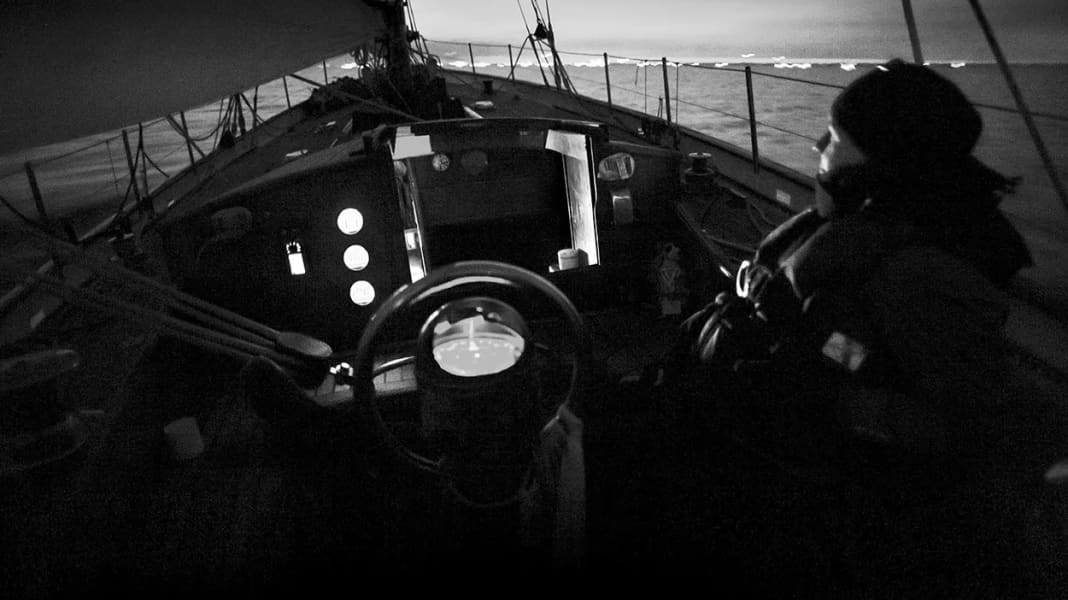
The topics in this article
We sailed into the evening twilight with a clear to aft wind and a pleasant swell. As the light faded, I could no longer see the waves rolling in. I had to feel them in order to steer clear of them. This transition from seeing to feeling was a fantastic feeling!" Christina Franzel-Beier enthuses about a trip into the night.
When darkness surrounds the boat, it becomes a microcosm in supposedly unfamiliar surroundings. All the colours around it fade, with lights flashing here and there. For many sailors, this instils a great deal of respect or even fear. Especially if they are on holiday with a small crew and are not experienced long-distance sailors. But night sailing has its own special charm; there is hardly a sailor who doesn't talk about it with shining eyes.
"We like to sail through the night, especially at the beginning of our holiday cruise, to arrive quickly in a more distant area - or because there's nothing interesting for us to discover on the way there," says Christina's partner Edgar Prochnow. The couple have a boat moored in South Holland.
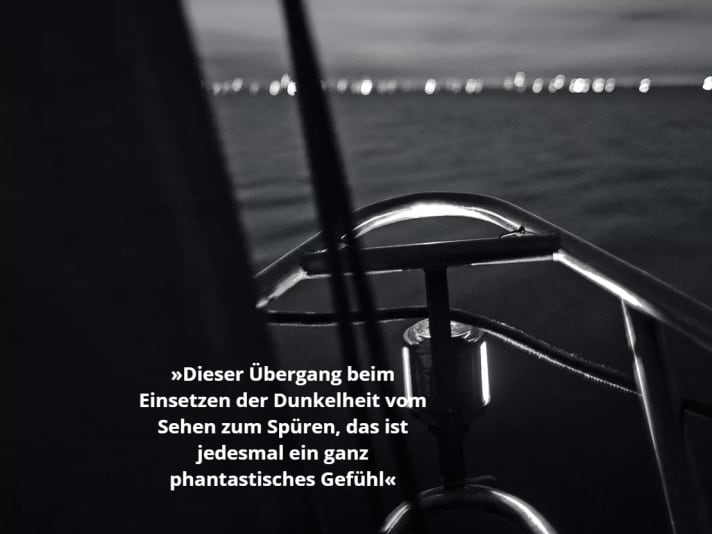
"You finally get out of the normal haze of weekend cruises. And you can easily save four days travelling on a 24-hour trip," say Sandra Böschen and Philipp Schußmann. During their last summer cruise, they took three night shifts and managed to sail from Fehmarn to Samsø and Gullholmen, Marstrand and Malmö in ten days - and all in a very relaxed way.
In one go from Cuxhaven to the IJsselmeer or from Heiligenhafen to Kalmar, a new sailing world has already been discovered. Another advantage of sailing in the evening: most of the others have long since moored in the harbours. The large playground is almost all yours. Good reasons to spend the night at sea!
Admittedly, finding your way around in the dark is not easy at first. If you are unsure, you can slowly approach a complete night journey. For example, you could wait a few hours after dusk before heading for your home port.
When there is little or nothing to see out at sea apart from the lights of buoys, towers and ships, it can be confusing. Robert Eichler, owner of the Hamburg sailing school of the same name, knows this. That's why he offers night trips on the particularly excitingly illuminated Elbe with its high volume of ships. These trips are part of his training programme for the recreational boating licence, because: "The students should see for once that the pictures in the books with their silhouettes do not correspond to reality." In fact, as Eichler knows from his experience of numerous night trips to Heligoland, light guidance and recognition can be practised particularly well at dusk. "From the moment the buoys ignite until darkness falls, there is plenty of time to do this in our latitudes. What you experience during this time is much easier to remember than what you learn in theory."
All that is needed for a relaxed night sail is a little preparation and, ideally, a summer night with fine weather and moderate winds. Tina Leveque-Emden, sailing instructor and Yachtmaster Offshore, also points out another important component: "Is everyone ready? Anxiety or tiredness before setting off into the night are not ideal conditions," she emphasises. "Good mental preparation is the be-all and end-all!"
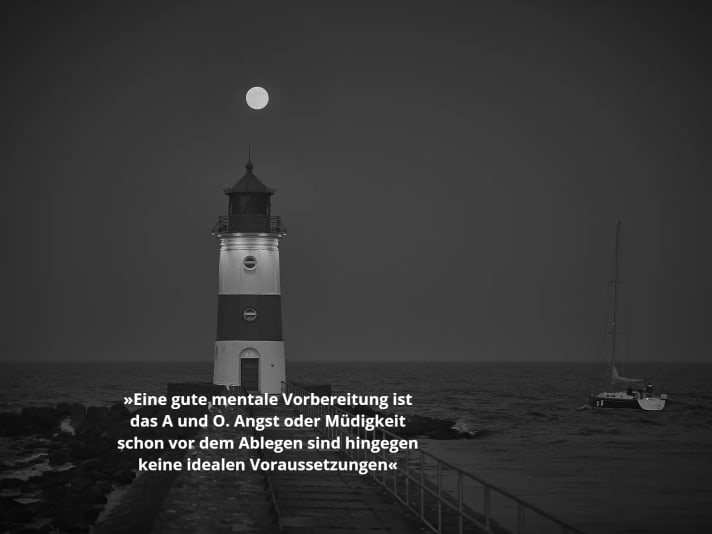
The better the preparation and planning, the safer everyone involved will be. Clear agreements also help to get through the night well - even with crews that have known each other for a long time. However, the more experienced crew member should be available at all times, especially if there are differences in experience. He or she will only be able to sleep peacefully when it is clear that nobody in the cockpit is overestimating themselves.
Once these interpersonal issues have been clarified, the practical preparations can begin: Clear on and below deck, check navigation instruments and lighting and prepare everything that needs to be quickly to hand in case of doubt.
There's nothing to stop you making yourself comfortable below deck. Instead of the berth in the aft peak, a saloon berth can also be prepared for this purpose. Then the helmsman can quickly speak to his sleeping partner from the cockpit. And vice versa, the helmsman can check that everything is OK up top with a quick blink.
"We always eat something warm beforehand, which gets us through the night," says Edgar Prochnow, addressing another point. A thermos flask with hot water for tea and packet soups as well as snacks or sweets should also be to hand.

Careful route planning in advance also prevents stress at night. "You should use every resource at your disposal for planning," advises Tina Leveque-Emden, "for example, ask experienced sailors about the special features of the area and look at the destination harbour via Google Earth, because you can even make out individual pits and dolphins on the satellite images."
Not everyone will want to call at a foreign harbour in the dark. The best solution is to plan a route which, based on a planned arrival time in daylight, determines the appropriate starting time based on distance and assumed speed. Wind and weather forecasts are also used for this purpose. Ideally, you will be guided safely to your destination by lights and lighthouses - and arrive when landmarks and harbour entrances are visible.
It is helpful to first get an overview of the course on the paper chart and then enter it into the plotter. Finally, like the cheat sheet at school, a handwritten sketch with all the important waypoints and buoys helps to memorise the course. It can be a blessing to have all the information about the course and sea area quickly to hand, especially when tiredness clouds your concentration during the dog watch.
Identification of beacons
The identifiers of beacons in the nautical chart have abbreviations that stand for the English name of the respective light. This overview provides a quick overview






What's more, you can't always rely on the technology or its users. "Christina prefers to navigate the classic way with the nautical chart, while I use the plotter," explains Edgar Prochnow, adding: "One night on the French coast, I pressed the wrong button and suddenly had an overlay that suggested I was travelling over land. Christina's map navigation was the only quick fix." Something like this always happens when you least need it: in bad weather - or at night.
Once the lines have been cast off, the ideal night at sea may be waiting out there: the crescent moon bounces glitteringly over the waves, there are endless stars to count in the sky and the wake shines in the sea light. It hardly ever gets really dark in midsummer. Then it can be difficult to escape this magic and go to bed.
Lateral buoys, sector fires, cardinal buoys
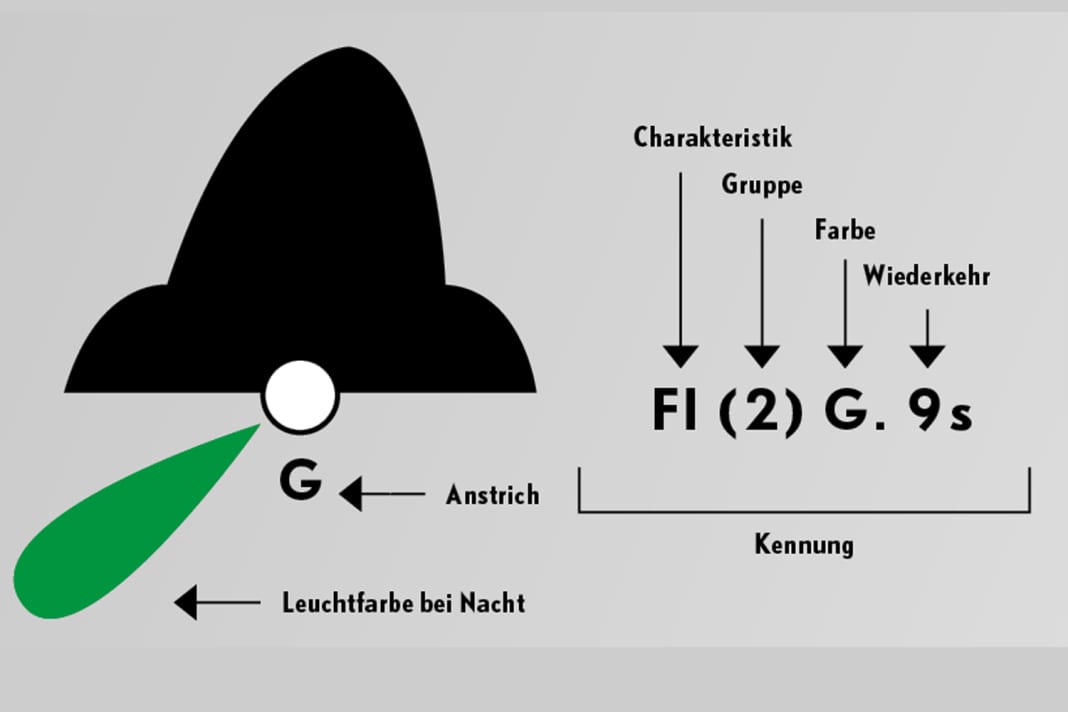



However: "Sleeping in between also has to do with self-discipline. If you reach the point of total fatigue, you may still be able to react in a tricky situation thanks to an adrenalin kick. But in the end, you become less and less focussed and can no longer keep your eyes open," says Christina Franzel-Beier from her experience of numerous night drives.
"We don't have a fixed watch schedule, but we try to take turns every two to three hours. Resting is important," say Sandra Böschen and Philipp Schußmann. Many crews of two do the same. Always with the agreement: "Never go on the foredeck when I'm below! And wake me up if something happens!"
Evasion rules
The size and direction of travel of ships at night are very different in reality than in the textbooks. In addition, distances cannot be estimated in the dark. Everyone would probably prefer to avoid close encounters, especially with large vessels. However, if red, green and white lights are visible at the same time, there is a risk of collision. To avoid this, you should recognise who needs to take evasive action by looking at the lights of other pleasure craft, as not all of them have AIS. The diagrams provide an overview of the evasion rules according to the COLREGs.
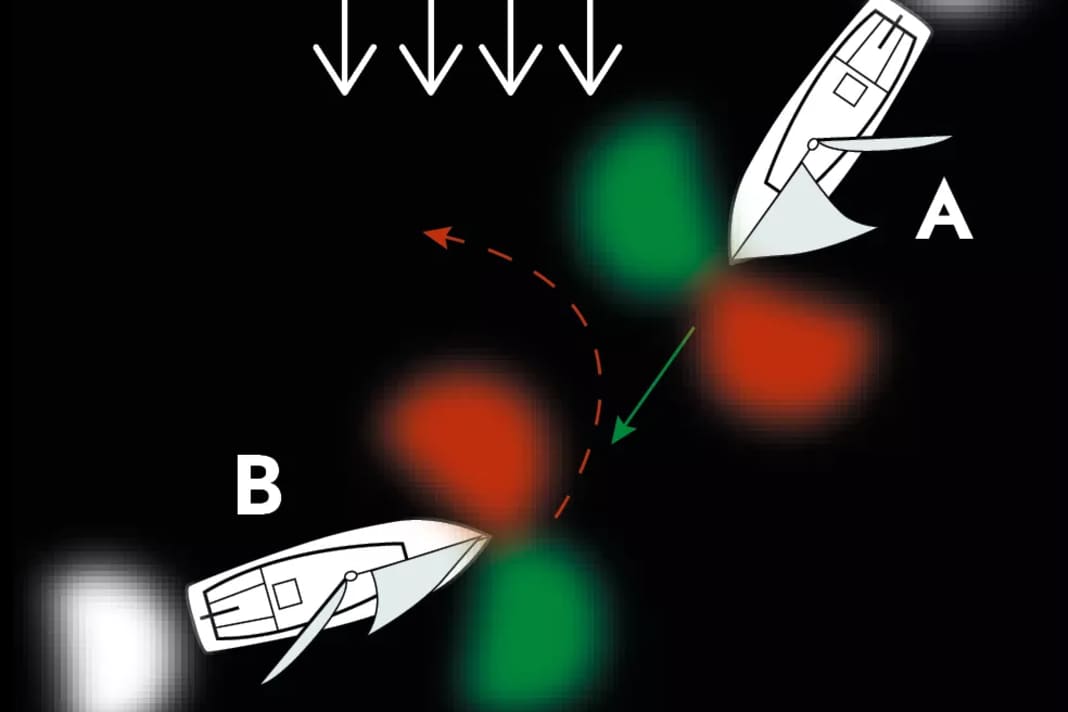





This can be the case when crossing shipping lanes or when vessels in the vicinity cannot be clearly identified straight away. In such cases, the AIS does not necessarily help either, as many pleasure craft do not have one and fishermen sometimes switch it off. Cruise ships and ferries glitter like Christmas trees at night, and construction sites, such as wind farms, can be so brightly lit that the navigation lights cannot be recognised.
In addition, distances cannot be estimated in the dark. Just as the brain plays tricks on us by trying to compensate for our lack of vision: It sometimes creates contours from shadowy contrasts that rarely correspond to reality when viewed in the light. As a general rule, bright light on board should be avoided so that night vision does not suffer. Red light is a good alternative. Tina Leveque-Emden recommends: "I have installed LED reversing lights for bicycles on the cockpit, galley and chart table. They can be charged via USB and are available for little money." In the red dim light, it is easy to get into the bunk, and the eyes are spared until a strip of light gradually rises above the sea again.
Encounters with fishing boats
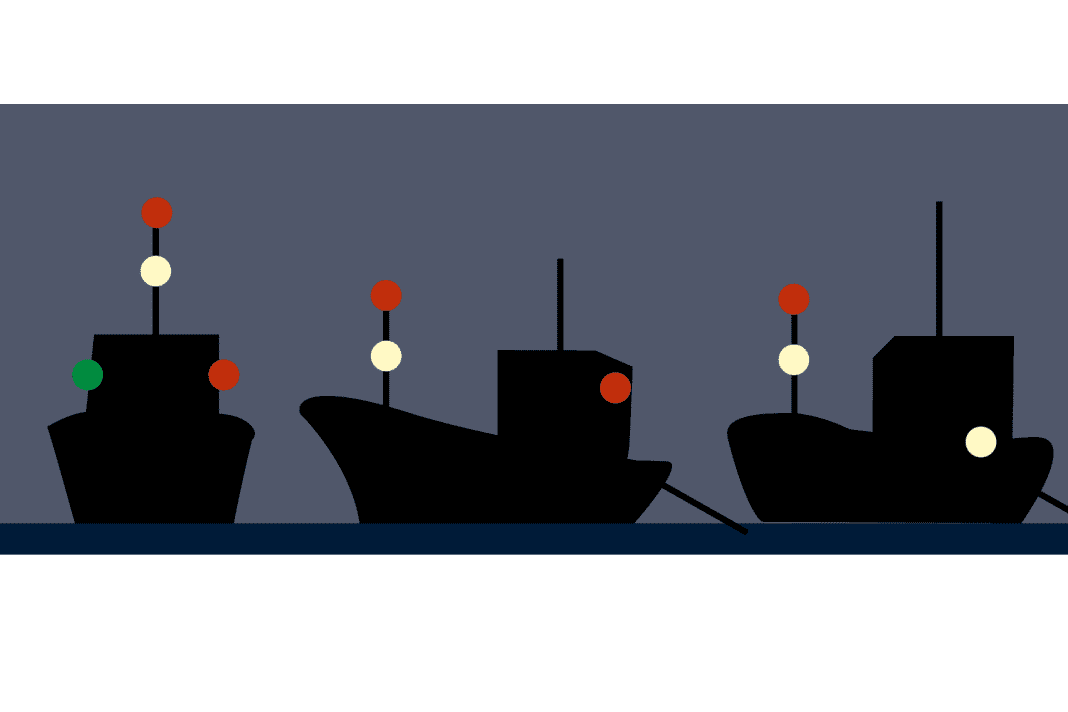


Then the most beautiful, final act of the night drive begins for many: the sunrise. With a steaming cup of coffee in your hand and perhaps the smell of freshly baked bread rolls, you can watch the first rays of sunshine dispel the haze. How contours become dimensions again. How the light makes the world ahead shine in its usual colours.
Checklist for preparing a night journey
Suddenly it's colder than expected, and my hat and gloves are in the back of the locker. The genoa rails have to be adjusted, but no lifebelt is to hand. This can be avoided with good preparation. How to get through the night comfortably and, above all, safely:
- Only start in stable weather conditions and sail into the night with rather defensive sails
- If necessary, plan the route so that you reach your destination at first light
- If possible, alternate between sleeping in and sleeping out during the day
- Attach dark pieces of fabric to the shrouds. They show the wind direction well at night
- Tension stretch ropes and have lifebelts ready
- Stow everything safely below deck. Close the sea valves. Make the bunks seaworthy
- Clear up on deck and in the cockpit, watch out for tripping hazards
- Take a walk around the deck before nightfall
- Keep ready to hand: warm clothing, torch and/or searchlight, handheld radio, binoculars, bearing compass and winch cranks, emergency light beacon
- Also useful are: a head torch, ideally with a red light, an audio book or music (without headphones!) and a short-term alarm clock to remind you to look round every 15 minutes while on watch
- Do the life jackets have lights? If not, put glow sticks in the jacket that can be activated in an emergency
- Check position lights, instrument lighting and lamp batteries
- Eat a hot meal before the start of the trip and have snacks and hot drinks ready for the night
Create a route plan
A route plan drawn up by several crew members gives everyone a sense of security and orientation. Then everyone can find their way around at night when the watch is changed. Bear the following points in mind when preparing:
- First mark out the course on the nautical chart, then enter waypoints for the route in the plotter
- If possible, avoid main traffic routes or traffic separation areas and do not plan your route too close to land. Fishing nets, currents or shallows are more likely to be encountered there
- Watch out for unlit buoys and, if possible, plan your route well away from them
- Have a piece of paper with a sketch of the rough route ready at the sat nav station. Write down the bins with the exact lights and tick them off one by one on the way
- Mark important points or turning points. Discuss when two people are in the cockpit, such as in the area of traffic separation zones or main routes
- Check the destination harbour for night-time accessibility: Is the entrance lighted, is the approach complicated? If so, is the buoyage lit at night or is the approach by plotter acceptable? Is there likely to be a lot of lighting (buildings, traffic lights) in the background? If in doubt, it is better to plan so that the harbour is approached in daylight
- In tidal areas, also note the tidal currents and watch out for possible wind-against-current situations. These can be unpleasant. Avoid dangerous passages, such as sea channels or narrow passages
- Have manuals, beacon directories and nautical charts to hand
- Make a plan B with emergency or alternative ports or bays
- Obtain the latest weather report. Anticipate what changes in the wind are to be expected, for example changes from sea breeze to land breeze, weakening, jets and downdraughts
- Do you still have the most important information about light guidance/fire detection? If not, have the corresponding deck legend ready in the cockpit
Night sailing with charter yachts allowed?
Charter crews can also extend their route with a night trip and reach more remote destinations in this way. Dirk Kadach from the charter company 1. Klasse Yachten in Heiligenhafen reports that many of his customers choose to sail through the night, especially in the Baltic Sea, for example to sail to Bornholm in one long trip. In the Mediterranean, on the other hand, it is rather rare to sail in the dark.
"Night sailing with our charter yachts is generally not prohibited, neither according to our general terms and conditions nor for insurance reasons," reports Kadach. But watch out: This is not the case everywhere!
Peter Kollmann-Jehle is a yacht agent at Master Yachting in Würzburg. His agency organises charter boats worldwide. He knows: "Not every charter company allows night sailing. The terms and conditions provide information on this." He cannot quantify the proportion of charter companies that prohibit night sailing. But: "In the Caribbean in particular, night sailing is almost always prohibited due to the many reefs and shallows," says Kollmann-Jehle. Crews must take this into account when planning their cruise. If you explicitly want to sail at night with your charter yacht, you should inform your agent or ask at the local charter base.

